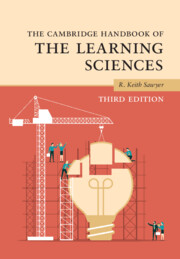Book contents
- The Cambridge Handbook of the Learning Sciences
- The Cambridge Handbook of the Learning Sciences
- Copyright page
- Contents
- Figures
- Tables
- Contributors
- Preface
- 1 An Introduction to the Learning Sciences
- Part I Foundations
- Part II Methodologies
- Part III Grounding Technology in the Learning Sciences
- Part IV Learning Together
- 19 Knowledge Building and Knowledge Creation
- 20 Computer-Supported Collaborative Learning
- 21 Arguing to Learn
- 22 Informal Learning in Museums
- Part V Learning Disciplinary Knowledge
- Part VI Moving Learning Sciences Research into the Classroom
- Index
- References
21 - Arguing to Learn
from Part IV - Learning Together
Published online by Cambridge University Press: 14 March 2022
- The Cambridge Handbook of the Learning Sciences
- The Cambridge Handbook of the Learning Sciences
- Copyright page
- Contents
- Figures
- Tables
- Contributors
- Preface
- 1 An Introduction to the Learning Sciences
- Part I Foundations
- Part II Methodologies
- Part III Grounding Technology in the Learning Sciences
- Part IV Learning Together
- 19 Knowledge Building and Knowledge Creation
- 20 Computer-Supported Collaborative Learning
- 21 Arguing to Learn
- 22 Informal Learning in Museums
- Part V Learning Disciplinary Knowledge
- Part VI Moving Learning Sciences Research into the Classroom
- Index
- References
Summary
This chapter reviews collaborative argumentation, where a community of learners works together to advance the collective state of knowledge through debate, engagement, and dialogue. Engagement in collaborative argumentation can help students learn to think critically and independently about important issues and contested values. Students must externalize their ideas and metacognitively reflect on their developing understandings. This chapter summarizes the history of argumentation theory; how arguing can contribute to learning through making knowledge explicit, conceptual change, collaboration, and reasoning skills; how argumentation skill develops in childhood; and how argumentation varies in different cultural and social contexts. The chapter concludes by describing a variety of tools that scaffold effective argumentation, including through computer-mediated communication forums and argumentation maps.
Keywords
Information
- Type
- Chapter
- Information
- The Cambridge Handbook of the Learning Sciences , pp. 428 - 447Publisher: Cambridge University PressPrint publication year: 2022
References
Accessibility standard: Unknown
Why this information is here
This section outlines the accessibility features of this content - including support for screen readers, full keyboard navigation and high-contrast display options. This may not be relevant for you.Accessibility Information
- 4
- Cited by
